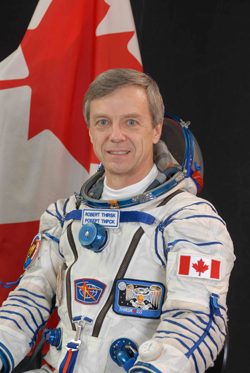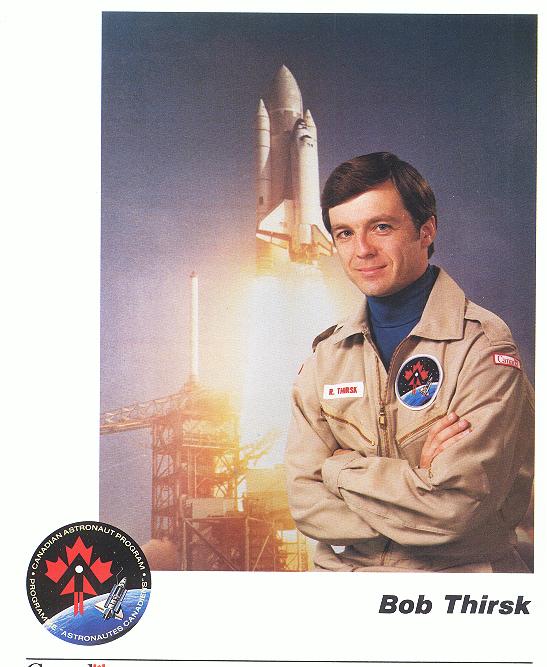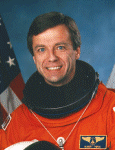RSC
Energia bio
(Apr 09) |
 Robert
Brent THIRSK Robert
Brent THIRSK
ISS Flight Engineer,
Soyuz ÒÌÀ TSC Flight Engineer,
Canadian Space Agency Astronaut, Canada
BIRTHPLACE AND DATE:
Born August 17, 1953, New Westminster, British Columbia, Canada.
EDUCATION:
Attended primary and secondary schools in British Columbia, Alberta
and Manitoba.
Received a Bachelor of Science degree in Mechanical Engineering from
the University of Calgary in 1976, a Master of Science in Mechanical Engineering
from the Massachusetts Institute of Technology (MIT) in 1978, a Doctorate
of Medicine from McGill University in 1982, and a Master of Business Administration
from the MIT Sloan School of Management in 1998.
FAMILY STATUS: Married.
Wife: Brenda Biasutti, Montreal, Quebec. They have three children.
HOBBY: hockey, playing the piano, flying, rest with his family.
WORK EXPERIENCE:
Dr. Thirsk was in the family medicine residency program at the Queen
Elizabeth Hospital in Montreal when he was selected in 1983 for the Canadian
Astronaut Program. He began astronaut training in February 1984 and served
as backup payload specialist to Marc Garneau, the first Canadian astronaut
for the October 1984 Challenger shuttle mission (STS-41-G).
He served as crew commander for two space mission simulations: the
seven-day CAPSULS mission in 1994, at Defence Research and Development
Canada in Toronto, and the 11-day NEEMO 7 undersea mission in 2004 at the
National Undersea Research Center in Key Largo, Florida. He led an international
research team investigating the effect of weightlessness on the heart and
blood vessels. He works with educational specialists in Canada to develop
space-related curriculum for grade school students. Initiatives such as
Canolab, Space for Species, and Tomatosphere have allowed thousands of
young Canadians to experience the thrill of scientific discovery.
He performed his first space flight on June 20 - July 7, 1996 as a
payload specialist aboard the Columbia shuttle (STS-78) with Life and Microgravity
Spacelab (LMS) in the payload module. During the flight he and his crewmates
performed 43 international experiments devoted to the study of life and
materials sciences. The life science experiments allowed to investigate
changes in plants, animals, and humans under space flight conditions. The
materials science experiments examined protein crystallization, fluid physics
and high-temperature solidification of multi-phase materials in a weightless
environment. The flight duration was 16 days 21 hours 48 min. Dr. Thirsk
is a Canadian record-holder of staying in space.
In August 1998 he was assigned by the Canadian Space Agency to NASA's
Johnson Space Center in Houston, Texas, to participate in the training
program for flights on the shuttle and ISS, where he passed training as
a mission specialist. The training program involved advanced instruction
on the shuttle and space station systems, EVA (spacewalk), robotic operations,
and Russian language.
Within the NASA Astronaut Office, Dr. Thirsk served as a ÑÀÐÑÎÌ
(capsule communicator) for the International Space Station (ISS) program.
ÑÀÐÑÎÌs participate in actual and
simulated space missions as a communication link between the Mission Control
Centers and the astronauts in orbit, CAPCOMs speak directly with the space
station crew, and assist with technical planning for the mission and last-minute
troubleshooting.
In 2004, Dr. Thirsk trained at Yuri Gagarin Cosmonaut Training Center
and became certified as a Flight Engineer for the Soyuz spacecraft. He
served as backup Flight Engineer to European Space Agency (ESA) astronaut
Roberto Vittori and passed training as the backup crew flight engineer
for the Soyuz ÒÌÀ-6 transport spacecraft under the
program of Russian Expedition 8 to the ISS (VC-8). At a period of January
16 - 27, 2007 he took part in the training for survival within the preliminary
crew, together with Oleg Kononenko (Russia) and Andre Kuipers (the Netherlands).
The training was provided in the forest 30 km from Moscow.
On June 16 - 22, 2008 in Sevastopol (the Ukraine) Dr. Thirsk participated
in the training within the preliminary crew, together with Alexei Ovchinnikov
(Russia) and Richard Garriot (USA) in case of the descent vehicle water
landing.
In August 2007 he was preliminarily assigned to the prime crew of Expedition
20 to the ISS (ISS-20). On February 12, 2008 NASA officially declared on
his assignment to this crew. On November 21, 2008 his assignment was reconfirmed
by NASA when declaring the ISS-20 - ISS-26 crewmembers.
April 2009.
By the data of site www.astronaut.ru
and the Canadian Space Agency site. |
|




 Dr.
Robert (Bob) Brent THIRSK
Dr.
Robert (Bob) Brent THIRSK
 Robert
Brent THIRSK
Robert
Brent THIRSK